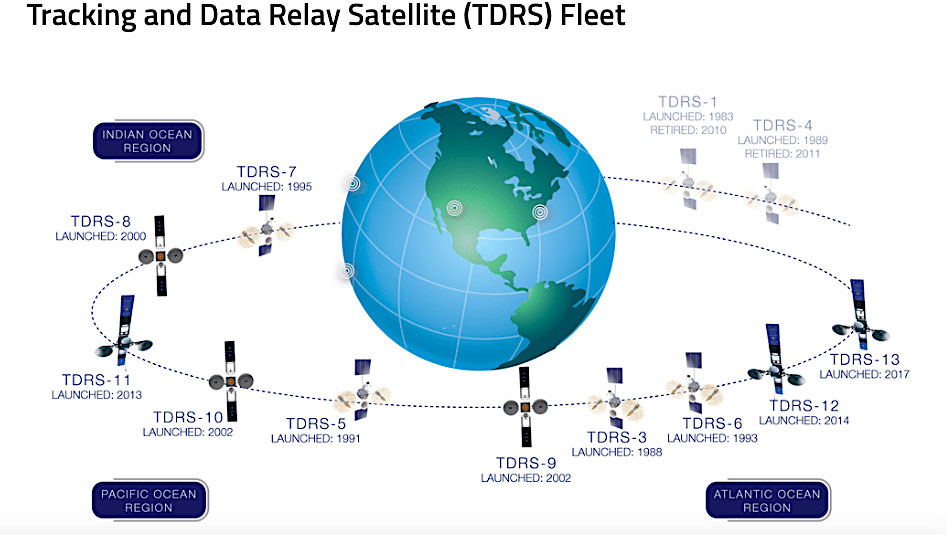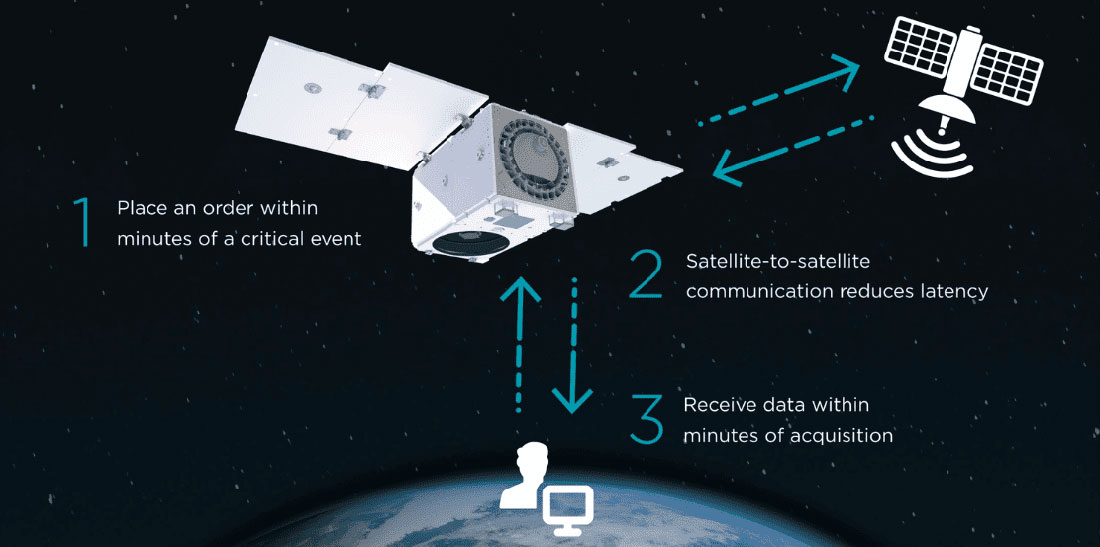 NASA would like to replace the current TDRS constellation of data-relay satellites with a commercial service around the end of the decade. Planet, SES Government Solutions and Telesat will be demonstrating a commercial solution on on Planet’s LEO, SES’s GEO and MEO, and Telesat’s GEO and Planet’s LEO constellations. Credit: NASA
NASA would like to replace the current TDRS constellation of data-relay satellites with a commercial service around the end of the decade. Planet, SES Government Solutions and Telesat will be demonstrating a commercial solution on on Planet’s LEO, SES’s GEO and MEO, and Telesat’s GEO and Planet’s LEO constellations. Credit: NASA
LA PLATA, Maryland — Satellite geospatial imagery service provider Planet Labs will be outfitting one or more of its new-generation Pelican highresolution satellites with radio-frequency inter-satellite-link terminals to communicate with geostationary- and non-geostationary-orbit satellites owned by SES and Telesat under contracts with NASA.
The inter-satellite terminals to be placed on Planet’s Pelican spacecraft will communicate to GEO-orbit SES and Telesat satellites in C-band, and in Ka-band to SES’s medium-Earth-orbit O3b mPower constellation and Telesat’s future Lightspeed constellation in low Earth orbit.
Lightspeed construction has not yet begun as Telesat settles the project’s financing. SES’s 11-satellite mPower constellation is scheduled to begin launches this year.
The three operators’ work is funded under NASA’s Communications Service Project (CSP). The agency’s intent is to explore commercial successors to the current Tracking and Data Relay Satellite System (TDRSS), which is being retired. TDRSS notably services to maintain a link between the International Space Station, orbiting at 400 kilometers in altitude, and NASA ground control.
SES Government Solutions announced the contract in May and said its share, with Planet, is valued at $29 million. SES said technology demonstrations of the inter-satellite communications service should be completed, in orbit, by 2025.
The company said NASA likely will seek “multiple long-term contracts to acquire services for near-Earth operations” by 2030.
Planet said it will use the work to introduce inter-satellite links to its constellation “to leap forward in speed of delivery to commercial customers – going from data delivery timelines on order of hours from existing constellations down to minutes with future systems – bringing value to users across a range of applications from disaster response to national security.”
Planet-mounted ISLs to be RF, not optical
For the moment, Planet said the terminals to be installed on the Pelican satellites will all be radio-frequency, not optical. Any communications with Telesat’s Lightspeed, which intends to use optical inter-satellite communications, will arrive at the Lightspeed spacecraft us radio frequencies.
 Planet will leverage work done under a NASA contract with SES and Telesat to deploy RF inter-satellite links on its future Pelican constellation. Credit: Planet
Planet will leverage work done under a NASA contract with SES and Telesat to deploy RF inter-satellite links on its future Pelican constellation. Credit: Planet
Planet on Aug. 26 sent over the following responses to Space Intel Report questions about the contract.
Is Planet a subcontractor to SES GS, or to SES GS and Telesat?
Planet is a participant on both SES GS and Telesat’s demonstrations.
As part of this, Planet says it will “accelerate R&D” to accommodate inter-satellite comms on your future EO satellites. So this hardware will be placed on several of your Pelican satellites?
Yes
The program will feature C-band links on SES GEO-orbit satellites and Ka-band on one or more of SES’s O3b mPower satellites?
Yes
Planet said the three companies will “align our respective technology investments and business opportunities to create ultra-low-latency communications.” This new alignment will only come after the demonstration phase of this contract?
Yes
For the Telesat piece, Planet will host RF inter-satellite-link terminals on its satellites. Telesat then would test the links on its GEO orbit spacecraft. But Telesat would also test relays between optically linked LEO satellites before downloading to NASA operations centers. Are you also going to demonstrate a laser optical relay terminal on your spacecraft?
Planet’s RF user terminals will interface with Telesat Lightspeed, which are in turn connected with other Telesat Lightspeed satellites with OISLs. Planet is not participating at the moment in any OISL activity with Telesat. The technology that we are developing as part of the CSP program is RF-based.
Planet said ground and in-orbit demos should start in 2023. The project includes actual in-orbit testing between Planet and SES satellites?
Yes
How will this work with Telesat? Construction on Telesat’s proposed LEO-orbit Lightspeeed constellation has not begun and it’s not clear when the satellites will be in orbit.
With Telesat, Planet will work to build a high speed inter-satellite-link solution to communicate with the Telesat Lightspeed constellation in low Earth orbit, proving out the ability for global real-time communication via satellite-to-satellite links.
Read more from Space Intel Report.
